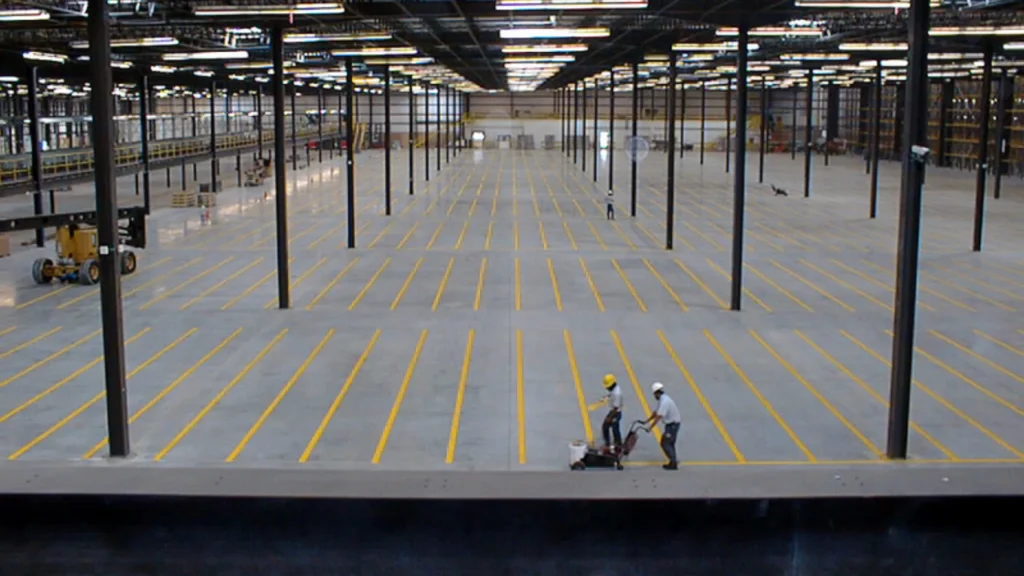Warehouse painting may seem like a simple task, but it’s actually an important part of maintaining the space. Being painted well is not only a way of making the warehouse look professional, but can be used to enhance the safety, cleanliness and the overall longevity of the space. Painting the interior of a warehouse or updating a warehouse’s surface, or even applying special coatings to parts such as paint booth walls, it is worthwhile to have a good plan for putting it all together to accomplish the task.
Whether it is selecting the correct warehouse paint or getting your surface ready, some tips will make sure that your warehouse not only looks nice, but lasts the next several years.
Why is Warehouse Painting Important?
We should first discuss the reason why such a job is so essential to any warehouse owner or manager before delving into the tips to achieve the success of the warehouse painting process. Warehouse painting is not all about the beauty it is about creating an efficient, safe and functional environment. We should have a better look at the reasons why it is necessary to paint your warehouse.
Why Should You Invest in Warehouse Painting?
- Protects the Structure: Paint is used to cover the concrete or metal structure in order to protect against wear and tear, moisture and even chemicals that may damage the structure over time.
- Improves Safety: The clear floor markings and paint on the walls make the warehouses safer. As one case in point, the walls of paint booths are frequently painted with special coverings to assist in the criteria of cleanliness and safety standards.
5 Essential Tips for Warehouse Painting Success
And since we have already covered the importance of warehouse painting and the minimum actions to take, we are ready to go into the top 5 tips to make sure that painting your warehouse is a success.
1. Prep the Surface Thoroughly
The use of proper surface preparation is important for a durable and long lasting finish. The best warehouse paint in the world can be painted on the surface but in this case the surface must be cleaned and prepared well to ensure that the paint sticks well and it will not peel with time.
- Clean the Floor and Walls: Get rid of dirt, dust, oil and grease. In case of floors, apply a concrete cleaner or any degreaser to loosen up the stubborn stain. In the case of walls, merely washing them down with water and a small amount of detergent will be sufficient.
- Patch Up Cracks: You should patch up the cracks in the walls or the floor with an appropriate patching compound prior to painting. This will make the surface smooth and without defects.

2. Choose the Right Type of Paint for Your Warehouse
It is essential to pick the appropriate warehouse paint. Not every paint is made to the same situations and as such it should be ensured that one chooses a type of paint that fits the unique requirements of the warehouse.
- Epoxy Paint: Epoxy is another preferred option for painting the floor in warehouses. It is long lasting, resistant to chemicals and gives a long lasting finish. This kind of paint is applicable in industrial settings and traffic prone places.
- Polyurethane Paint: This is an ideal paint that can be used in places where there is sunshine or where there is high moisture as this paint is coated with UV protection and is also durable.
- Acrylic Paint: Acrylic paints can be considered in cases where there is not much traffic, and you need to make it work with a low cost. They are simple to work with and they dry quicker as compared to epoxy but not as hardy.
3. Apply the Paint Evenly
To achieve a smooth and professional finish, it is important that it is applied smoothly. Get the proper equipment and use the paint systematically. Here are some tips:
- Use a Roller for Large Areas: When it comes to covering a section of the wall or floor, it is best done by a roller as it can cover a greater area. Always remember to apply to high walls or ceilings using a long-handheld roller.
- Use a Brush for Edges: For corners and edges apply with a brush to cover all the areas but when going around obstructions such as pipes or beams.
- Apply Thin Coats: This is preferred to one thick coating. This will aid in the prevention of drips and ensure that one layer dries before another layer is applied.
4. Allow for Proper Drying and Curing Time
Once the paint has been applied, drying and curing are the next significant steps to take. This guarantees that the paint gets hard and bonds well to the surface.
- Drying Time: The time taken by most paints to dry before they become touchable varies from several hours. Do not dry faster than the manufacturer recommends.
- Curing Time: Although the painting may be dry to the touch, it may take as long as 7 days to completely dry depending on the type of paint being applied such as epoxy, which is a type of industrial grade paint.
5. Maintain the Painted Surface Regularly
After a paint job, one should take care of it regularly so that the surface remains appealing and the life of the paint is increased. Cleaning up the floor or the wall, also touching up worn-out spots, and wear and tear inspections are examples of regular maintenance.
- Regular Cleaning: Clean the floor through sweeping and mopping. In the case of painted walls, surfaces will be dusted and wiped down to make them appear clean.
- Reapply Paint as Needed: Since warehouses have a lot of foot or vehicle traffic, certain areas of the workforce might need to be repainted on occasion, particularly floors.

Benefits of Warehouse Painting
Having discussed the process of painting a warehouse, we can discuss its advantages:
- Improved Safety: The better design of safety through proper floor markings and well-painted walls makes the work much safer by indicating the areas to perform the particular duties that are likely to cause accidents.
- Increased Durability: Paint will provide greater protection on the surface, which extends the life of the warehouse floor or walls, and saves you money in repairs.
- Enhanced Appearance: A painted-up warehouse would be more professional, organized, and welcoming to both employees and visitors.
Conclusion
Painting of the warehouse is an essential process of ensuring that the working environment is functional, clean and safe. When using these 5 tips, you can be sure that your warehouse flooring or walls have been painted in a way that will last many years. Since it is possible to prepare the surface, select the suitable paint, and put it in place, each of the steps contributes to the success of the project.
To get professional painting done on your warehouse and to make sure that everything is perfect with your facility, pay a visit to Knapp Painting. Our services are to offer the best painting services based on the requirements of your warehouses.
FAQs
Wipe the floor well, clean up, fill a crack and etch the floor when necessary so that the paint adhesion is correct.
The best kind of paint that should be used on the walls of the warehouse is epoxy or polyurethane paint because these two types of paint are durable and wear-resistant.
Yes, though it must be prepared well, the correct choice of paint and applied smoothly. It is better to consider hiring professionals.
The dry time of the paints varies, with the majority of paints taking 4-6 hours to dry and up to a week to cure.
It is also based on foot traffic and wear, though generally the time to renew the paint is after 2-3 years.a













